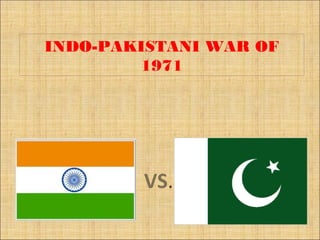The document summarizes the Indo-Pakistani War of 1971 between India and Pakistan over the independence of East Pakistan (now Bangladesh). It provides background on the politics and geography of Pakistan and India. The causes of the war included East Pakistanis feeling marginalized and demands for greater autonomy. The war began when Pakistan launched air strikes on India and engaged Indian forces on the western front. India supported the Mukti Bahini resistance in East Pakistan and achieved victory in December 1971 after the surrender of over 90,000 Pakistani troops, leading to the independence of Bangladesh.





















